This is a special blog that won’t exist without sharing.
In the middle of July, our reader, Ann, emailed us her question about “how to clean microscopes between children” under the current condition of COVID-19. I have to say, “This is a very important question, but I never think of it.” I appreciate Ann bringing this critical question to us.
I spent a weekend brainstorming and experimenting. I came up with an idea and discussed it with Ann. Ann, a retired teacher, also tried and experimented on her side. Finally, we consolidated our thoughts into this article.
We hope this article will be useful to you. We also look forward to hearing any feedback/common/questions. Please leave your message at the end of this article or email us at help@rsscience.com
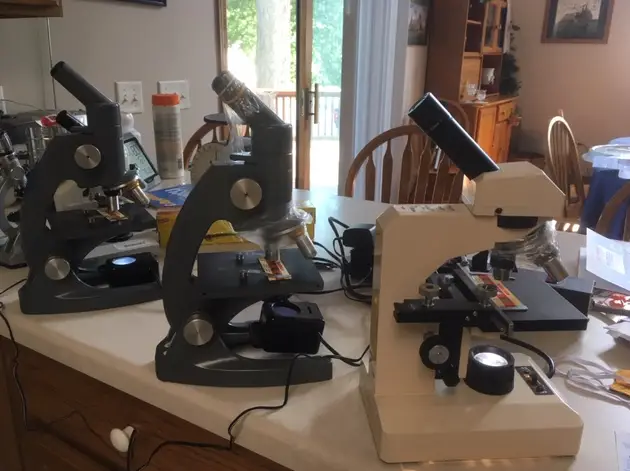
[In this figure] Microscopes with plastic wrap on essential parts.
Ann has equipped her microscopes ready. A pandemic cannot stop us from the training of future scientists!
This article covers
Minimize opportunities for exposure, but how to do it?
We all know that wearing PPE (personal protective equipment, like face masks, goggles, lab coats, and gloves) and cleaning the area after touching is good practice to minimize the risk of COVID-19 spreading. However, it is somehow difficult to implement during a group teaching with microscopes.
First, I assume that we may not have enough PPE for every student.
Second, I don’t recommend cleaning the microscopes with 70% alcohol or any other disinfection reagents too frequently because it may damage microscopes.
Under these circumstances, what can we do?
An economic way to protect everyone and microscopes
Our idea is to cover the microscope parts that each user may touch with plastic wrap. Between users, the plastic wrap cover will be replaced to prevent potential viruses from transfer. Plastic wrap is economical, easy to obtain, and has no supply issue.
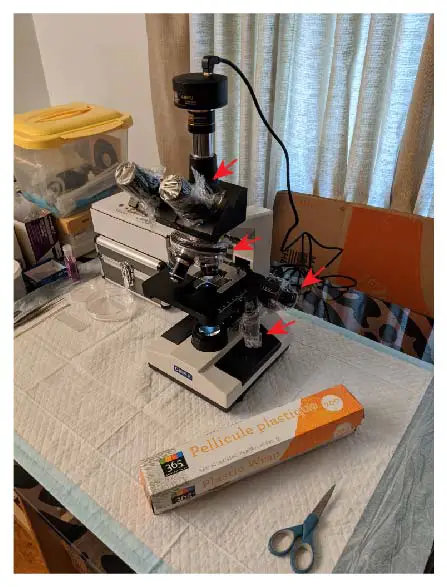
[In this figure] My setup of the microscope station.
The red arrows indicate the area wrapped with plastic wrap.
In fact, in the surgical room of hospitals, it is a routine procedure to cover the medical instrument (like the lamp’s handle, microscope/endoscope, surgical robots, and even computer keyboard/mouse) with disposable sterile plastic wrap between two patients. You may also see the same practice in dental clinics.
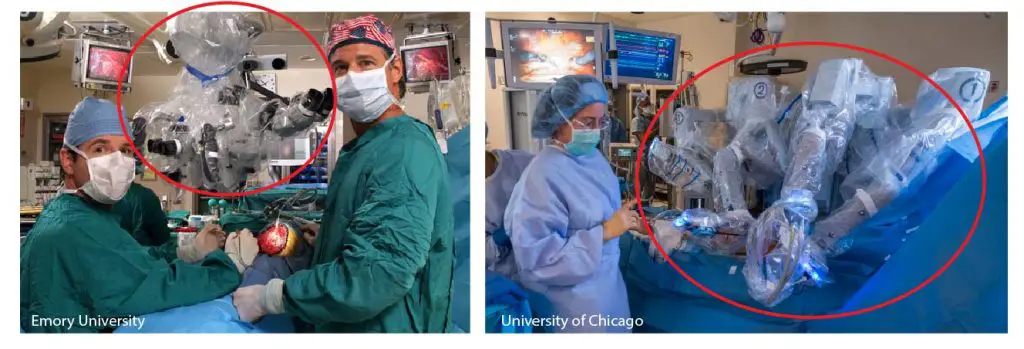
[In this figure] Examples of a microscope (left) and surgical robots (right) protected by a sterile plastic wrap (red circles).
Photo credit: Emory U; Uchospitals
The same concept could also apply for other science instruments, such as telescopes and binoculars.
What microscope parts should be covered?
I covered all the essential parts of a microscope that I may touch. It includes:
(1) eyepieces,
(2) nose piece,
(3) light switch and brightness adjustment,
(4) stage control, and
(5) coarse and fine adjustments.
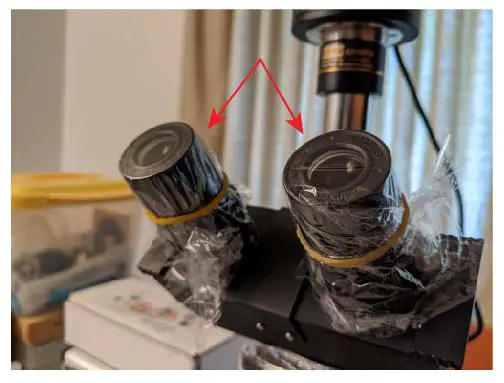
[In this figure] Cover the eyepieces with plastic wrap and rubber bands (red arrows).
If the plastic wrap covering the eyepieces is flat without wrinkles, it does not affect the viewing at all. Rubber bands can tightly hold the plastic wrap and keep it flat.
(Ann said: “Even my picky husband agreed viewing was not affected!”)
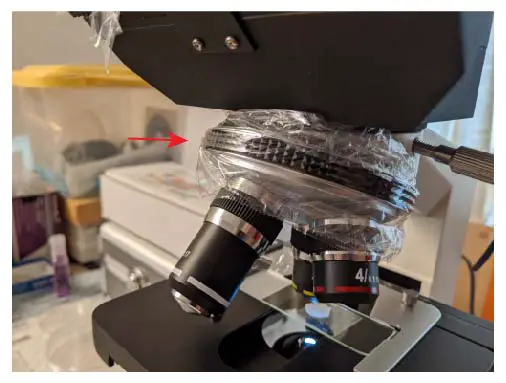
[In this figure] Cover the nose piece with plastic wrap (red arrows).
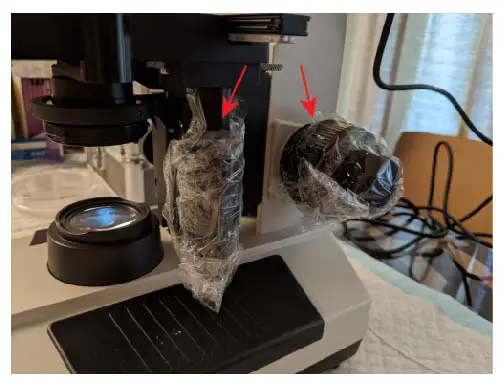
[In this figure] Cover the stage control, coarse, and fine adjustments with plastic wrap (red arrows).
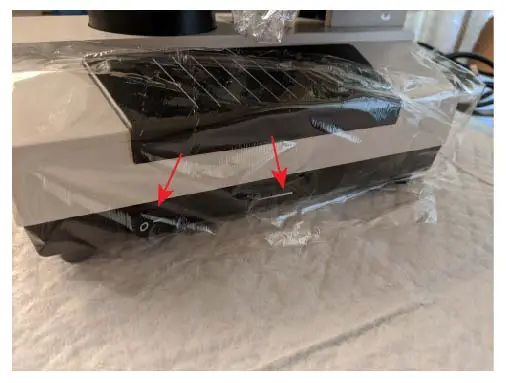
[In this figure] Cover the light switch and brightness adjustments with plastic wrap (red arrows).
Note: If you use stereo microscopes or your microscope has other parts (like exchangeable filters, binocular distance adjustor, diaphragm/condenser, or camera/computer), you can decide which parts you want to cover depending on the usage.
The choice of plastic wrap
Probably any brand of kitchen plastic wrap should work for this purpose. I used Pellicule Plastique Plastic Wrap from Whole Foods Market.
Ann tested several brands. She found that Saran Premium Wrap stuck better than Glad Cling Wrap. Glad Press’n Seal works very well on knobs, etc. It clings to itself better than the others. It is a bit more manageable (until it sticks to itself). It is easier to cut into smaller pieces. It stuck nicely over the light switches. However, Glad Press’n Seal is not for the eyepiece because it is not transparent.

[In this figure] Saran Premium Wrap is a good choice.

[In this figure] Glad Press’n Seal sticks very well but it is not transparent.
Let’s applaud for her efforts and enthusiasm of the experiment!
A step-by-step guide
To implement this technique in the classroom, what I would do is to ask my students to follow the step-by-step preparation below before switching to a new microscope station.
1. Clean the hands with hand sanitizer (if possible, having one bottle of hand sanitizer at each station).
2. Cover the five parts of microscopes with pieces of plastic wrap.
Note: Tearing plastic wrap off the carton may be a bit challenge for young kids. Teachers may need to assist them (with gloves) or prepare in advance some pre-cut pieces of plastic wrap
3. Use and view the microscopes without touching other uncovered parts of microscopes.
4. After usage, remove the plastic wrap and toss it into a trash can.
Note. Depending on the usage, you may not need to change every piece of plastic wrap. For example, if the student only views but not adjusts other parts at the microscope station (the teachers have already set up and focused the specimens), it may only require to replace the plastic wrap covering the eyepieces.
5. Repeat the same practice when the next user comes.
6. After the usage of the last student, the teacher performs a more thorough cleaning of the microscopes. Don’t spray alcohol directly to the microscopes. Wet a piece of tissue or lens paper with 70% alcohol to clean the surface. Clean the lens if immersion oil is used. Let the microscopes dried for 10 or more minutes before putting on the cover or placing into the storage box.
We have two articles about taking care of your microscopes:
13 Tips You Should Know about Taking Care of Your Microscope
How to Use Microscope Immersion Oil to Get Higher Resolution Images
Please contribute your feedback and comment!
What do you think? Is it doable? We would love to hear your feedback. If you find any question, please let us know. Let’s make it better together.
If you think this article is useful, please share with more people. How great it will be to have teachers feel comfortable using microscopes this year!
Thank you.

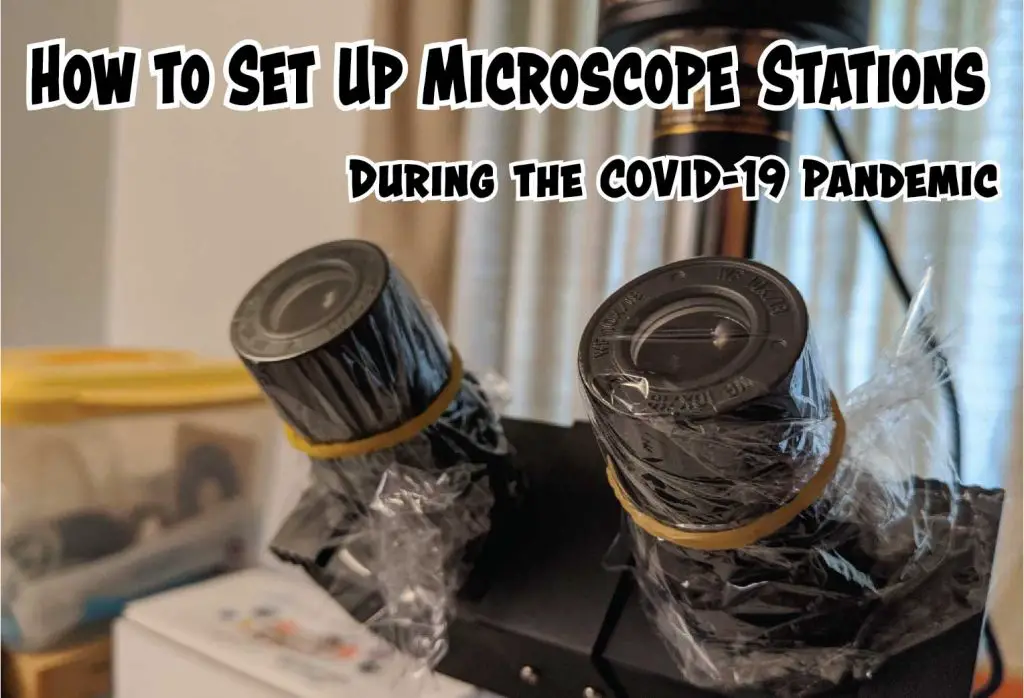
We found a mixture of equal parts ethyl ether acetone and absolute alcohol (ethanol) isopropyl alcohol, will do for cleaning microscope optics. Never soak, and use farmaceutical cotton wool. The mixture evaporates very quickly and doesn’t get the chance to soak in between the lens elements.
Great! Thanks for sharing!